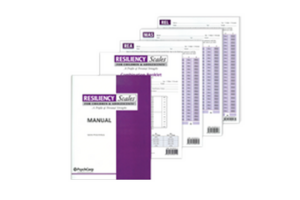Description
Resiliency Scales for Children & Adolescents™ A Profile of Personal Strengths (RSCA) is a tool to profile personal strengths, as well as vulnerability in teens and children.

Resiliency Scales for Children & Adolescents™ A Profile of Personal Strengths (RSCA) is a tool to profile personal strengths, as well as vulnerability in teens and children.
Resiliency Scales for Children & Adolescents™ A Profile of Personal Strengths (RSCA) is a tool to profile personal strengths, as well as vulnerability in teens and children.
Sandra Prince-Embury, PhD
Overview:A tool to profile personal strengths and vulnerability
Age Range:9:0-18:0
Administration:5 minutes per scale
Reading Level:3rd grade
RTI Tiers:RTI Levels 1 and 2
Forms:Three stand-alone global scales
Norms:Representative of the U.S. population within gender by ethnicity and parent education level for children ages 9-18
Scores/Interpretation:T scores for global scales Scaled scores for subscales
Publication Date:2006
Now, a tool to profile personal strengths, as well as vulnerability in teens and children down to nine years
The Resiliency Scales for Children & Adolescents™ measures the personal attributes of the child that are critical for resiliency. The scales are composed of three stand-alone global scales of 20-24 questions each and ten subscales:
Normed with the Beck Youth Inventories–Second Edition to link a Resiliency Profile with specific symptoms for more targeted treatment planning
Ideal for identification and prevention, this tool allows you to compare the difference between a child’s experience of personal resources with their experience of emotional reactivity.
Creating a Clinical Psychology of Resilience (PDF – 37 KB)
Canadian Journal of School Psychology
The Canadian Journal of School Psychology has dedicated a special issue on “Resiliency: Translating Theory into Application for Children and Adolescents,” with Dr. Sandra Prince-Embury as the guest editor. Dr. Prince-Embury is the author of Resiliency Scales for Children and Adolescents which is featured on the articles below.
Comparison of One-, Two-, and Three-Factor Models of Personal Resiliency Using the Resiliency Scales for Children and Adolescents
Sandra Prince-Embury and Troy Courville
Abstract:
This article examines the scale structure of the Resiliency Scales for Children and Adolescents(RSCA). Confirmatory factor analysis reveals that a three-factor model is a better fit than one- or two-factor models for the normative sample. These findings lend support to the construct validity of the RSCA. The three-factor model is discussed as a framework that is useful in systematically relating critical aspects of resiliency in children and adolescents for the purpose of clinical intervention.
Canadian Journal of School Psychology 2008 23: 11-25.
To view the full article visit http://cjs.sagepub.com
*Must be an online subscriber
Measurement Invariance of the Resiliency Scales for Children and Adolescents With Respect to Sex and Age Cohorts
Sandra Prince-Embury and Troy Courville
Abstract:
This article examines invariance of the three-factor structure of the Resiliency Scales for Children and Adolescents across age band and gender within normative samples. Confirmatory factor analysis reveals that the three-factor model fits for all groups. In addition, invariance analysis shows no statistical differences in factor structure between males and females. A three-group confirmatory factor analysis across age bands demonstrated partial invariance between age bands.
Canadian Journal of School Psychology 2008 23: 26-40.
To view the full article visit http://cjs.sagepub.com
*Must be an online subscriber
The Resiliency Scales for Children and Adolescents, Psychological Symptoms, and Clinical Status in Adolescents
Sandra Prince-Embury
Abstract:
The Resiliency Scales for Children and Adolescents (RSCA) are three scales for assessing the relative strength of three aspects of personal resiliency as a profile in children and adolescents. This article presents preliminary evidence to support the use of the RSCA in preventive screening. First, this article examines associations between the RSCA Global scale and index scores and psychological symptoms as assessed by the Beck Youth Inventory—II in a normative sample of adolescents. A normative sample was chosen as screening would presumably occur in a non-clinical setting. Findings suggest associations between psychological symptoms and the RSCA scale and index scores. Specifically, positive associations were found between psychological symptoms and the RSCA Vulnerability Index and the Emotional Reactivity scale score. Negative associations were found between psychological symptoms and the RSCA Resource Index, Sense of Mastery, and Sense of Relatedness scale scores. Second, the RSCA is examined as a potential predictor of clinical status differentiating the normative sample from a clinical sample. Results support the use of the RSCA in screening protocols for the identification of vulnerability that does not rely on the presence of an identified disorder or clearly defined psychological symptoms.
Canadian Journal of School Psychology 2008 23: 41-56.
To view the full article visit http://cjs.sagepub.com
*Must be an online subscriber
Hays, R., Prince-Embury, S., & Chen, H. (1998). RAND-36 Health Status Inventory: Technical manual. San Antonio, TX: The Psychological Corporation.
Prince-Embury, S. (2007). Resiliency scales for children and adolescents: Profiles of personal strength. San Antonio, TX: Pearson.
Prince-Embury, S., Courville, T. (2008a). Comparison of a one, two and three factor models of the Resiliency Scales for Children and Adolescents. The Canadian Journal of School Psychology, 23(1), 11-25.
Prince-Embury, S., Courville, T. (2008b). Measurement invariance of the Resiliency Scales for Children and Adolescents across gender and age cohorts. The Canadian Journal of School Psychology, 23(1), 26-40.
Prince-Embury, S. (2008a). The Resiliency Scales for Children and Adolescents, psychological symptoms and clinical status in adolescents. The Canadian Journal of School Psychology, 23(1), 41-56.
Prince-Embury, S. (2008b). Translating resiliency theory into application with children and adolescents. The Canadian Journal of School Psychology, 23(1), 4-10.